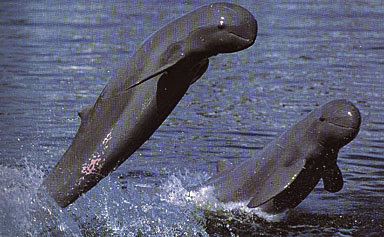Those of you who watch for news about conservation or marine mammals might have gotten very excited when media agencies started spouting out this week that an "Asian Dolphin, Feared Dying, Is Thriving" or a "Huge population of rare dolphins discovered." You might have been inspired that "Study finds 6,000 rare dolphins off Bangladesh" or that "Rare Dolphins Discovered Deep In Jungle". You might have felt better about the world, when "Thousands of rare Irrawaddy dolphins found along Bangladesh coast" told you that "The discovery of a new population is an important finding as scientists and conservation groups do not know how many Irrawaddy dolphins remain across south and south-east Asia. The species, related to orcas or killer whales, were listed in 2008 as "vulnerable" on the IUCN's "red list" of endangered species due to declines in known populations."
 The claim is that - WOW! - a "previously unknown" population of 6,000 Irrawaddy Dolphins (Orcaella brevirostris) has been found off of Bangladesh. Since their population estimates were in the "hundreds until now", we should all be excited to have located this large group of dolphins. Clearly, now, we can save them!
The claim is that - WOW! - a "previously unknown" population of 6,000 Irrawaddy Dolphins (Orcaella brevirostris) has been found off of Bangladesh. Since their population estimates were in the "hundreds until now", we should all be excited to have located this large group of dolphins. Clearly, now, we can save them!
Here's what they forget to say, or say so flippantly you'd think it wasn't important.
- The dolphins were not - I REPEAT: WERE NOT - just discovered. They were found five years ago, in 2004. The study was published about them in 2005. So this isn't a "new" group of rare dolphins - it's just fresh reporting of a group we've known about for years.
- The 6k or so are already factored into the IUCN Red List, which places the population status at "Vulnerable" (one of the endangered categories). Despite the "big group", they're still endangered, and populations are still decreasing. Here's what the report has to say in 2008 (the emphasis is mine):
The species was listed as Data Deficient in 1996, but a great deal of new information has become available and five subpopulations have been listed as Critically Endangered since that time. Where the species has been studied: (1) subpopulation sizes are generally low (10s to low 100s) with the single exception of Bangladesh (approximately 5800), (2) there have been significant range declines, and (3) threats, especially bycatch and habitat degradation, have been well documented and remain severe and pervasive. Even within the largest known population of the species in Bangladesh (see above), opportunistic observations of deaths in drifting gillnets and reports from local fishermen suggest that bycatch rates are not sustainable (Smith et al. 2005).At least a 30% reduction in the range-wide population size is suspected over a period of three generations (45-48 years), including the past and future, based on increasing levels of bycatch and habitat degradation in recent years. Generation length (15-16 years) was assumed to be similar to that of Sotalia fluviatilis â a species that lives in similar habitat and has similar, but better known, life history characteristics (Taylor et al. 2007 estimated generation length for S. fluviatilis as 15.6 years). The species therefore qualifies as Vulnerable A4cd. Given the vast area and complexity of coastline inhabited by this species, it is unlikely that a more quantitative assessment of the global population will be feasible in the near future.
So why did the Times and other papers suddenly decide to report about these dolphins?
Because the Wildlife Conservation Society just wrote a press release about the research into the dolphin's populations that was published four years ago. They fail to mention that the discovery was in 2004. They fail to mention it was published before, too. They fail to mention that the numbers are already taken into account in the IUCN status, so the finding doesn't "change" anything about it. The Irrawaddy Dolphin is just as vulnerable as it was in 2008 when the red list came out. Basically, all they do is generate publicity by making it sound like a very at-risk species is suddenly thriving and maybe there's some new hope for this unique and amazing cetacean.
But there isn't, really, at least not any more hope than there has been for half a decade. And since they also noted that the bycatch rates are probably unsustainable, even in the large population, that hope is pretty slim anyhow unless more protections go into place to save this species. Populations are already probably down from that 6,000 number, and probably dropping every year.
The half a dozen or so misleading news articles only make it sound like we did something great this week in conservation - at least we made a wonderfully surprising discovery that should give us hope. And, at least in this case, we didn't. We didn't do anything at all.
